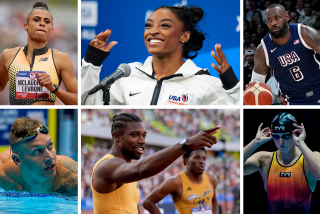BOXING
- Share via
Olympics boxing’s computerized scoring system, first used in 1992, may be changing the strategy of the sport. Under the system, each of the five ringside judges has a control panel from which they register a scoring blow. This is expected to give quick-punching boxers an edge in Atlanta, where the Cubans are expected to dominate.
WHAT WE KNOW
In amateur boxing, everybody defines himself by how well he fares against the Cubans. The American team is talented, young and relatively inexperienced compared to the Cuban team, which, once again, is jammed with savvy fighters who would be professional stars if their government permitted it. Cuban fighters won seven gold medals and two silvers at the 1992 Barcelona Games; the U.S. team’s only gold came from Oscar De La Hoya.
But the Cubans could be deeply wounded by the defection during training in Mexico of two 22-year-old gold-medal contenders, 178-pound Ramon Garbey and 125-pounder Joel Casamayor.
Depending on the draw, three of the U.S. team’s best medal contenders--1995 world and Pan American Games 178-pound champion Antonio Tarver, Pan American Games 156-pound champion David Reid; and Oxnard’s Fernando Vargas, the 147-pound representative--face potential showdowns with big-name fighters.
WHAT WE DON’T KNOW
In single-elimination Olympic boxing, scoring often brings controversy. In Barcelona, electronic scoring made its Olympic debut. The scoring won’t be displayed in Atlanta until after the bout ends. But the same system will be used, which means combinations (judges can’t react to three or four quick blows) and body shots (judges at bad angles can’t see the punch land) will not be advantageous.
SOMEONE YOU SHOULD KNOW
The acknowledged king of the event, Cuban heavyweight Felix Savon, who has won five consecutive world titles and is an overwhelming favorite to win his second Olympic gold medal.
Savon was the only fighter to win his 1995 world title match by knockout, which is something he could easily repeat in the Olympic tournament. The American heavyweight representative is Nate Jones.
SOMETHING YOU SHOULD KNOW
This is the only Olympic sport with an age limit--competitors must be 17 to 34.
RULES
Hits: White part of glove must hit opponent in head or front and side of body above waist. Points are the objective, not knockouts.
At a Glance
Number of athletes: 364
Changes since Barcelona: None
Qualifications: Regional and continental competitions have placed 20 to 32 competitors per weight class.
Format: Three rounds lasting three minutes each
Dates of competition: July 20-28, July 30-August 4
Locations: Alexander Memorial Coliseum, Georgia Tech
The Basics
The ring: Canvas surface cushioned by 1/2-inch padding. Three padded ropes enclose 20-foot square ring. Corners are padded.
Corner: Equipped with trays of resin to improve footing, seat, water bottles, basins of sawdust to absorb sweat and blood in ring, water buckets, first-aid kit.
Winning on Points: The most common victory, it is based on judges scores.
Winning when referee stops contest: Injury or a lopsided match will cause referee to stop match.
Winning by retirement: Opponent throws in the towel. Boxer or coach voluntarily quits.
Eight-count: Boxer is knocked down or stunned, referee counts to eight before continuing match. Referee uses standing eight to evaluate if boxer is able to continue. If not, he counts to 10 and ends match. Three eight-counts in one round or four in a match ends the fight.
Electronic scoring: Five judges, usually from five continents to ensure neutrality, score on new electronic system. When judges see a valid punch, they have one second to press the red or blue round button (corresponding to boxer’s color) on computer console. Three judges must validate punch. All valid punches count one point. Square buttons are for fouls.
Source: Atlanta Committee for the Olympic Games, Times staff, Associated Press
More to Read
Go beyond the scoreboard
Get the latest on L.A.'s teams in the daily Sports Report newsletter.
You may occasionally receive promotional content from the Los Angeles Times.






